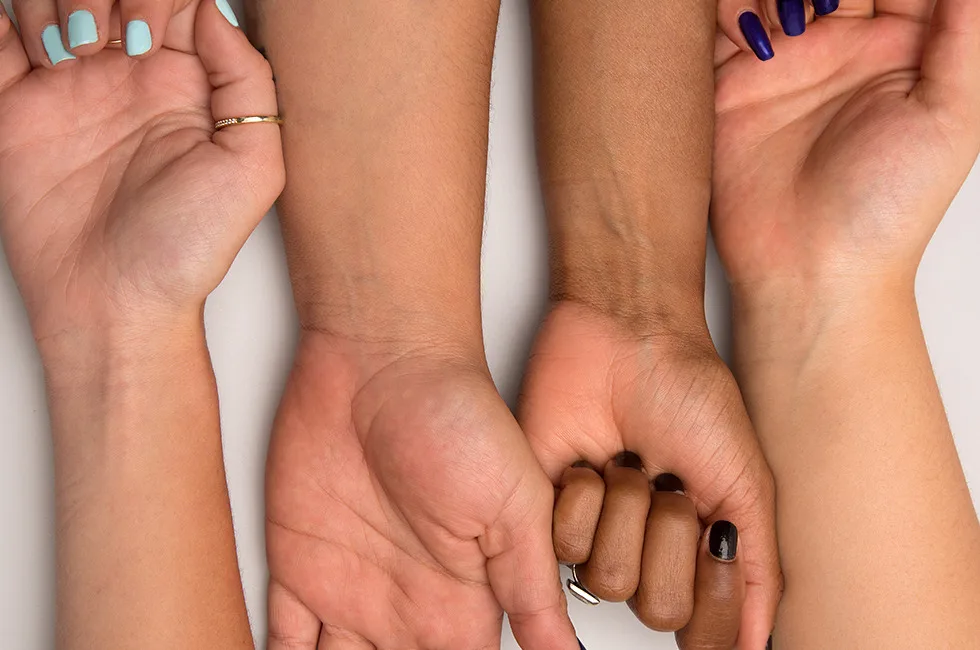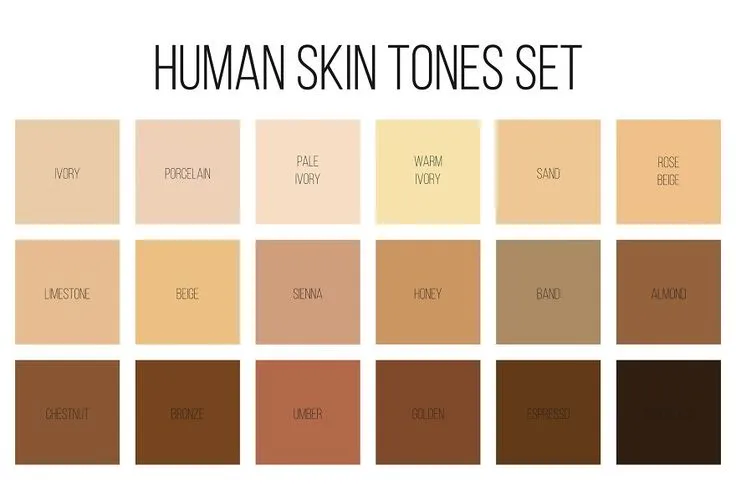There is nothing wrong with having the skin tone that we do because it is a trait that is clearly inherited from our ancestors and is related to our biology and genetics.
Every skin tone, from white to yellow to brown, is lovely. The amount of melanin in the epidermis of your skin determines the tone or color of your skin.
Olive skin color frequently has a green-yellow hue. As opposed to brown skin, which exhibits a tanned color that ranges from light to dark brown.
Many causes, including tanning, skin-lightening treatments, sun exposure, and dermatologist-recommended procedures, can cause irregular changes in skin tone.
Keep reading to know more about skin tones and how olive and dark-skinned color is produced.
What Is A Skin Tone?
The actual color of your skin’s surface is known as your skin tone. One of the reasons why people look different from one another is because of our varied skin tones.
Variations in pigmentation, which arise from genetics, sun exposure, natural and sexual selection, or any combination of these, determine an individual’s skin color.
We tend to be drawn to color first when looking for a new lipstick or foundation. Knowing your skin tone will help you choose foundation colors that complement it.
The term “skin undertone” refers to the color tone that lies beneath the top layer of your skin.
They won’t change no matter how much tanning or skin-lightening treatment you receive because they are permanent, unlike skin tones.
Types Of Under Tones

Warm, cool, and neutral undertones are the three conventional undertones.
Peach, yellow, and golden are all warm undertones. Sallow skin is present in some people with warm undertones. Pink and bluish tones are examples of cool undertones.
Your undertones will be nearly the same shade as your actual skin tone if you have a neutral undertone.
| Undertones | Color |
| Cool | Pink or blue hues |
| Warm | Yellow, Golden, and Peach hues |
| Neutral | Combination of warm and cool |
What Is Olive Skinned Tone?
Olive skin is generally light brown in color and lies in between dark and light skin tones.
How light or dark your olive skin tone is can also be greatly influenced by your undertone.
Many other middle-range skin tones can be mistaken for an olive skin tone. In fact, a lot of people with olive skin tones might not even be aware of it.
It can be lighter or darker, and with exposure to the sun, it might become even darker. It’s essential to mention that just because you have light skin, that doesn’t mean it isn’t an olive skin tone.
The tendency to tan is one of the characteristics of olive skin tones. Although they can burn, olive skin tones don’t burn particularly hot. When exposed to the sun, an olive skin tone is more prone to become tanned.
Nationalities That Have Olive Skin
Olive-skinned countries include Greece, Spain, Italy, Turkey, and parts of France.
You would not have considered Russia to be a nation that does, but reports suggest that people of this color do exist here. There are also quite a few olive-skinned folks in Ukraine.
Europeans often have paler olive complexion than residents of Asia, Central, and South America, or the Middle East.
Mexico, Honduras, Paraguay, Colombia, Argentina, and Costa Rica are typically thought to have dark brown or tan complexion. Yet, they could also have olive undertones to their skin.
Is Olive Skin Rare?
Olive skin tone is rare.
It can be challenging to tell whether you actually have an olive skin tone or are just tanned because an olive skin tone isn’t very prevalent.
Your undertones are the most crucial aspect that determines whether you have an olive skin tone.
Another factor is that whereas dark olive tones are often brown, light olive tones feature cream to beige tints. Olive skin tone is not very common, thus few people are aware of how to take care of it.
You could also have a natural olive tone if your skin appears gray or ashen.
As opposed to warm, cold, or neutral undertones, this is a combination of undertones, which is less frequent. Olive skin features a green undertone that is thought to be exclusive to the olive complexion and neutral and warm undertones.
What Is Dark Skinned Tone?

Humans with dark skin typically have high melanin pigmentation levels. Despite the fact that this usage can be confusing in some nations, people with particularly dark skin are frequently referred to as “black people.”
Your skin will be darker and you will be more secure if you have more melanin. Together with other elements, melanin serves as a “natural canopy” that shields your skin from dangerous radiation.
Without melanin, white skin can be compared to a transparent coating that allows damaging UV rays to permeate through to the skin’s deeper layers, while brown skin doesn’t.
A fear, hatred, or severe dislike of Black people and Black culture is known as Negrophobia. Brown-skinned persons are often discouraged and compared to being ugly by some people all over the world.
Beauty has no boundaries and should be admired in all its manifestations.
Which Country Has Dark-Skinned People?
Dark skin is typically associated with Africans, but that is not always true. It depends on the regions of Africa where one is born.
According to research, the Nilo-Saharan pastoralist groups of eastern Africa, including the Mursi and Surma, had the darkest complexion, while the San of southern Africa had the lightest. There were also various hues in between, such as that of the Agaw people of Ethiopia.
A study, which was made available online this week in Science, explores how these genes have changed throughout time and space.
While certain Pacific Islanders’ dark pigmentation can be traced back to Africa, gene variations from Eurasia also appear to have returned to Africa.
Surprisingly, some of the mutations that give Europeans lighter skin really originate in ancient Africa.
Why Do Humans Have Different Skin Tones?

Many other factors influence a person’s real skin tone, but the pigment melanin is by far the most significant.
Melanin is the primary factor in determining the skin tone of people with darker skin since it is produced by skin cells called melanocytes.
Thirty-six keratinocytes receive melanin from one melanocyte in response to signals from the keratinocytes.
They control melanocyte reproduction and melanin synthesis as well. People’s melanocytes create diverse amounts and types of melanin, which is the primary reason for their varied skin tones.
Light-skinned people’s skin tone is influenced by the blueish-white connective tissue underneath the dermis and the blood flowing through the dermal veins.
What Is The Difference Between Olive-Skinned People And Brown People?
If your skin undertone is medium, you could be unsure whether you belong in the tan or olive complexion category because the colors shift with the seasons.
Yet, the undertones remain unchanged, so you keep your true color underneath.
Olive skin is fair skin with a dark undertone, giving it a tint resembling evening beige. Its undertones are green, golden, and yellow. It’s sometimes referred to as light-tanned skin.
Brown skin has golden undertones and comes in many different colors of brown. It is darker than fair complexion and olive skin tones but lighter than deep skin tones.
This skin tone is found in people with light brown tones, such as those of Mediterranean and Caribbean ancestry. This category includes the Indian skin tone shine.
By comparing their undertones and the strength of the dark color, brown skin, and olive skin can be distinguished from one another readily.
Is Olive Skin The Same As Brown?
Olive Skin may seem to have shades of brown but isn’t exactly the same.
When people refer to having “olive skin,” they typically mean having a somewhat darker complexion with a naturally bronzed appearance.
However, the phrase can be used to describe a wide variety of hues, from those who are practically white to those who are quite black.
The undertones, which are typically greenish or golden, are the key to defining the phrase.
If you can see blue veins in your skin, you have cold undertones. You’re warm if the veins in your skin seem olive green.
Examples Of Some Skin Colors
Porcelain

The first skin tone on the Fitzpatrick Scale from type I is porcelain. It has a cold undertone and is one of the palest skin tones.
Porcelain skin can signify either of the following two things, depending on the context: As previously said, it can be used to describe someone with flawless, even-toned skin that is smooth and free of blemishes.
Veins that are blue or purple may be visible through the skin. Others may have translucent skin as a result of an illness or another condition that makes their skin thin or extremely light in hue.
Ivory

If you have extremely pale skin and think porcelain isn’t the right choice for you, consider ivory. It is a darker shade than porcelain and could have neutral, warm, or cold undertones.
Ivory has a yellow or beige hue and is warmer than pure dazzling white.
Due to the fact that this skin tone falls within the Fitzpatrick Scale Type 1, people with this skin tone should still avoid excessive sun exposure.
Conclusion
- Your undertones are the most crucial element in determining the color of your skin.
- If you have olive skin, you will generally have a warm undertone, such as light orange, apricot, or peach, or a cool undertone like pink or blue.
- Olive skin tones can range in color from lighter to deeper, and they are easily sun-tanned. This is common to people from the Mediterranean, Latin America, and some parts of Asia.
- Black and dark brown skin is thought to be better able to tolerate the sun. A high phototype does not, however, offer protection from its negative consequences.

